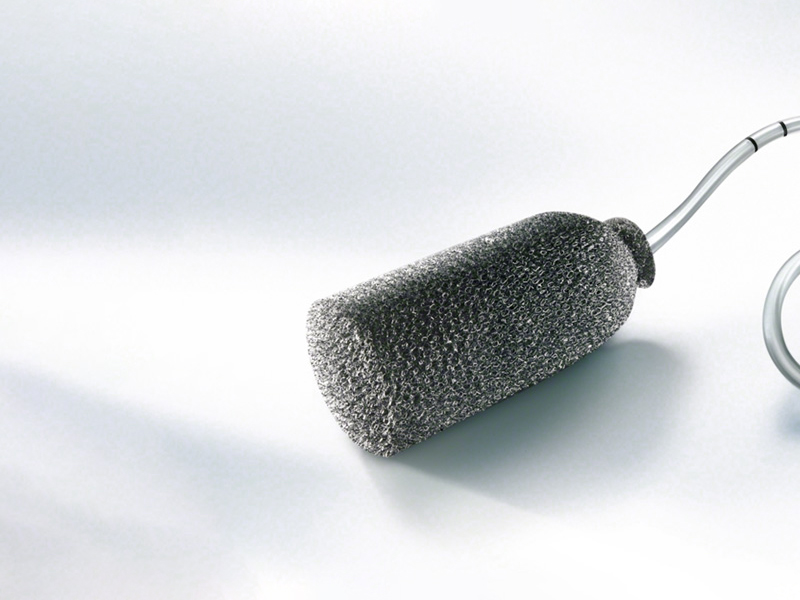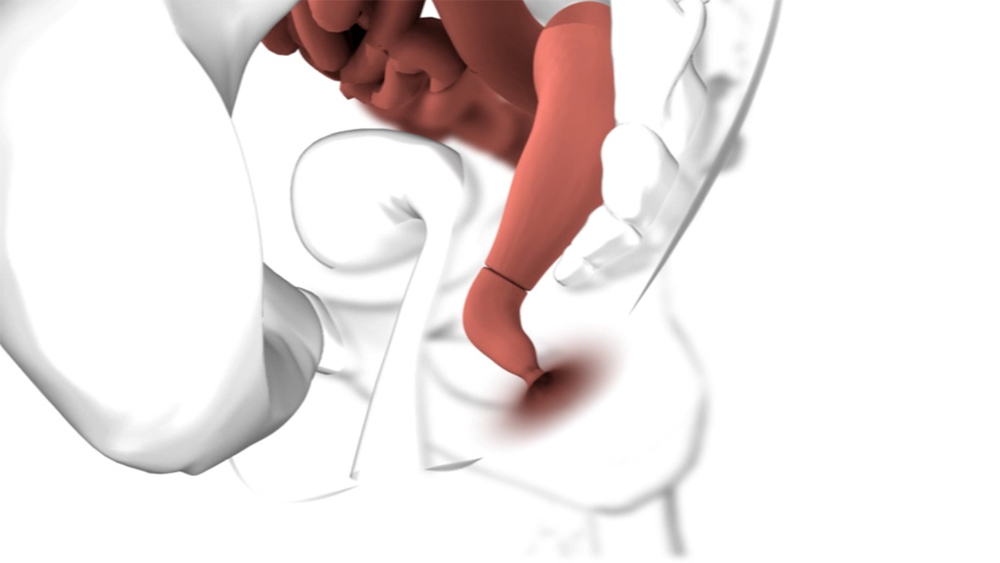Sei uscito con successo.
Not registered yet?
Area colorettale
Endo-SPONGE®
Metodo mininvasivo per il trattamento di perdite anastomotiche nell'area colorettale.

Sei un operatore sanitario?
Cliccando 'Confirm" dichiari di essere un operatore sanitario.
Se sei un paziente o un giornalista visita le pagine a te dedicate.
Conferma Sì, sono un operatore sanitario. Cancella No, non sono un operatore sanitario.Terapia del vuoto per il trattamento delle perdite colorettali

Indicazioni
Una soluzione unica per il trattamento delle perdite colorettali Endo-SPONGE® è indicato per i pazienti con insufficienze anastomotiche dopo chirurgia colorettale nella zona pelvica inferiore (posizione extra peritoneale) e segni di peritonite localizzata dell'addome inferiore.
Albero decisionale

Come funziona
Il principio di base della terapia del vuoto Endo-SPONGE® consiste nell'inserire una spugna a pori aperti nella cavità della perdita utilizzando un endoscopio flessibile. Un tubo di drenaggio collegato alla spugna viene fatto passare attraverso l'ano e collegato a un sistema di drenaggio della ferita a basso vuoto. Mediante l'aspirazione, si ottiene un drenaggio efficace e continuo, evitando l'accumulo di secrezioni nella cavità. La spugna nella cavità di fuoriuscita induce una pulizia dei rivestimenti di fibrina, oltre a restringere e pulire la cavità. Il sistema è collegato solidamente al flacone di drenaggio Redyrob® Trans Plus.

Come usarlo
Il trattamento viene eseguito con il paziente disteso sul lato sinistro. Può essere necessaria una leggera sedazione e analgesia. Per iniziare la procedura, il sistema di applicazione (il tubo esterno) viene spinto nell'endoscopio, il quale viene portato fino all'estremità della cavità di perdita. La spugna viene compressa e spinta nel tubo esterno. Dopo aver aperto completamente la spugna, il sistema di applicazione viene rimosso. L'estremità libera del tubo di drenaggio Endo-SPONGE® è collegata al flacone Redyrob® Trans Plus. Una volta posizionata correttamente, la spugna viene controllata endoscopicamente e viene applicato il vuoto.
Caso reale 1
La paziente affetta da carcinoma rettale, trattata con escissione della resezione mesorettale anteriore e totale e con sacca a J, ha sviluppato una perdita di anastomosi post-chirurgica di 20 cm di profondità.
Caso reale 2
Paziente di sesso maschile, 76 anni, una lesione sessile T1N0 escisso mediante chirurgia endoscopica trans-addominale. Rilevato 2 settimane dopo con una perdita anastomotica.
Evidenze cliniche
Molti anni di esperienza nel trattamento delle perdite anastomotiche con Endo-SPONGE® hanno ottenuto buoni risultati supportati da dati clinici.
La terapia sottovuoto endoluminale (EVT) per il trattamento delle perdite anastomotiche rettali è stata inizialmente descritta da Weidenhagen nel 2008. Da allora sono stati pubblicati diversi studi retrospettivi e prospettici di coorte utilizzando Endo-SPONGE® per trattare i difetti gastrointestinali inferiori (GI). Fino a 40 pubblicazioni hanno mostrato i loro risultati e le loro conclusioni.
Vantaggi del trattamento Endo-SPONGE®:
- Drenaggio continuo del fluido infetto dalla cavità [5]
- Tendenza a tempi di trattamento più brevi rispetto all'irrigazione [7]
- La durata media del trattamento è di 20-50 giorni [1], [5], [8]
- La chiusura per perdite anastomotiche si ottiene tra il 67 e il 100% [1], [7-12]
- Il trattamento funziona meglio quanto prima viene applicato dopo la diagnosi di AL [11], [13]
- Trattamento ambulatoriale possibile [1], [5], [7], [11], [12]
- Buona accettazione del paziente [1], [11], [12]
- Riduce la degenza ospedaliera [1], [14]
- Tendenza a ridurre lo stoma permanente (aumento del tasso di chiusura dello stoma) [10], [14]
- Tendenza a ridurre il numero di nuove operazioni [10], [15]
- È possibile ridurre il costo dei trattamenti con AL [11]
Vantaggi per il paziente

Possibile trattamento ambulatoriale
Buona accettazione del paziente
Ridurre la tendenza al reintervento
Ti interessa saperne di più sulla terapia del vuoto endoluminale Endo-SPONGE®?
Modulo di contatto per la terapia endoscopica sottovuoto[1] Riss S, Stift A, Meier M, Haiden E, Grünberger T, Bergmann M. Endo-SPONGE® assisted treatment of anatomotic leakage following colorectal surgery. Colorectal Dis. 2010 Jul;12 (7 Online):e104-8. more on Pubmed
[2] Mees ST, Palmes D, Mennigen R, Senninger N, Haier J, Bruewer M. Endo-vacuum assisted closure treatment for rectal anastomotic insufficiency. Diseases Colon Rectum. 2008 Apr;51(4):404-10. more on Pubmed
[3] Frasson M, Flor-Lorente B, Ramos Rodrıguez JL et al., ANACO study Group.Risk factors for anastomotic leak after colon resection for cancer: ultivariate analysis and nomogram from a multicentric, prospective, national study with 3193 patients. Ann Surg 2015; 262: 321-30. more on Pubmed
[4] Kuehn F, Janisch F, Schwandner F, Alsfasser G, Schiffnann L, Gock M, Klar E., Endoscopic Vacuum Therapy in Colorectal Surgery. J Gastrointest Surg. 2016 Feb;20(2):328-34. more on Pubmed
[5] Weidenhagen R, Gruetzner KU, Wiecken T, Spelsberg F, Jauch KW. Endoscopic vacuum-assisted closure of anastomotic leakage following anterior resection of the rectum: a new method. Surg Endosc. 2008 Aug;22(8):1818-25. more on Pubmed
[6] Argenta LC, Morykwas MJ (1997), Vacuum-assisted closure: a new method for wound control and treatment: clinical experience. Ann Plast Surg 38:563-576. more on Pubmed
[7] Nerup N, Johansen JL, Alkhefagie GA, Maina P, Jensen KH, Promising results after endoscopic vacuum treatment of anastomotic leakage following resection of rectal cancer with ileostomy. Dan Med J. 2013 Apr;60(4):A4604. more on Pubmed
[8] Riss S, Stift A, Kienbacher C, Dauser B, Haunold I, Kriwanek S, Radlsboek W, Bergmann M. Recurrent abscess after primary successful endo-sponge treatment of anastomotic leakage following rectal surgery. World J Gastroenterol. 2010;16(36):4570-4.
[9] Strangio G, Zullo A, Ferrara EC, Anderloni A, Carlino A, Jovani M, Ciscato C, Hassan C, Repici A. Endo-SPONGE® therapy for management of anastomotic leakages after colorectal surgery: A case series and review of the literature. Dig Liver Dis. 2015 Jun;47(6):465-9. more on Pubmed
[10] Shalaby M, Emile S, Elfeki H, Sakr A, Wexner SD, Sileri P. Systematic review of endoluminal vacuum-assisted therapy as salvage treatment for rectal anastomotic leakage. BJS open. 2018;3(2):153-60.
[11] Jimenez-Rodriguez RM, Araujo-Miguez A, Sobrino-Rodriguez S, Heller F, Díaz-Pavon JM, Bozada-García JM, de la Portilla F. A new perspective on vacuum-assisted closure for the treatment of anastomotic leak following low anterior resection for rectal cancer, is it worthy? Surg Innov. 2018;25(4):350-6.
[12] Arezzo A, Verra M, Passera R, Bullano A, Rapetti L, Morino M., Long-term efficacy of endoscopic vacuum therapy for the treatment of colorectal anastomotic leaks. Dig Liver Dis. 2015 Apr;47(4):342-5. more on Pubmed
[13] Borstlap WAA, Musters GD, Stassen LPS, van Westreenen HL, Hess D, van Dieren S, Festen S, van der Zaag, Tanis PJ, Bemelman WA. Vacuum-assisted early transanal closure of leaking low colorectal anastomoses: the CLEAN study. Surg Endosc. 2018;32(1):315-27.
[14] Milito G, Lisi G. Endoluminal Vacuum Therapy as treatment for anastomotic colorrectal leakage. Surg Technol Int. 2017;10(30):125-30.
[15] Weidenhagen R, Gruetzner KU, Wiecken T, Spelsberg F, Jauch KW. Endoluminal vacuum therapy for the treatment of anastomotic leakage after anterior rectal resection. Rozhl Chir. 2008 Aug;87(8):397-402. more on Pubmed
[16] McDermott FD, Heeney A, Kelly ME, Steele RJ, Carlson GL, Winder DC. Systematic review of perioperative, intraoperative and postoperative risk factors for colorectal anastomotic leaks. Br J Surg. 2015 Apr;102(5):462-79.Willis S, Stumpf M. Chirurg 2004, 75:1071-78. more on Pubmed
[17] Schintler MV. Negative pressure therapy: theory and practice. Diabetes Metab Res Rev. 2012 Feb;28 Suppl 1:72-7. more on Pubmed
Restate connessi con My B. Braun
Con il tuo account personalizzato, la tua esperienza online sarà più facile, più comoda e più sicura.

